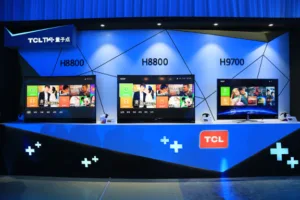Chinese TV manufacturer TCL launched its TV+ Curved QD TV model H8800S-CUD on April 8, 2015, combining the industry’s leading gamut with the best curvature by integrating both the Quantum Dot display and curved display technologies.
Leveraging this technical breakthrough, TCL is expected to take the lead in the global panel display industry, giving China more advantage to enhance its dominant position in the world’s TV industry.
TCL’s TV+ curved QD 4K UHD TV H8800S-CUD adopts quantum dot color enhancement materials and a curved display to achieve an unparalleled color gamut coverage of 110% NTSC for curved TVs. In H8800S-CUD, the core of the quantum dot enhancement film technology lies in the quantum dot enhancement film, a precision optical component with quantum dots added, which leads to an ultra high definition that distinctively outperforms the traditional LED backlit models and appeals to more high-end consumers. Besides, H8800S-CUD has also made a major breakthrough in its industrial design – a curved display with the largest curvature to date of 4000R to provide an immersive experience comparable to IMAX theaters.
H8800S-CUD fully demonstrates the concept of “Entertainment prevails”. It contains entertainment resources such as latest movies, massive videos, massive games and parent-child games. In future, it will add Tencent Video and Tencent Game resources, as well as Korean movies, TV series and variety shows provided by The K, a subsidiary of Apollo in Korea.
The global panel display industry has been dominated by three giants, namely China, Japan and South Korea, for years. The Chinese players include TCL, Hisense, Skyworth, Konka and Changhong; the Japanese players include Sharp and Sony; the Korean players include Samsung and LG. Industry insiders believe that the emergence of curved QD TV might give China more advantage in the industry. According to DisplaySearch, the global QD TV sales volume is expected to reach 1.3 million units in 2015, and it will grow to 5 million units by 2016, and further to 12 million by 2017 and more than 18 million by 2018.

